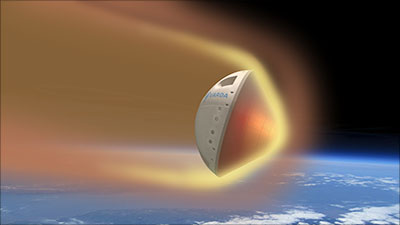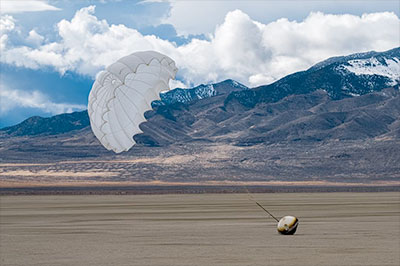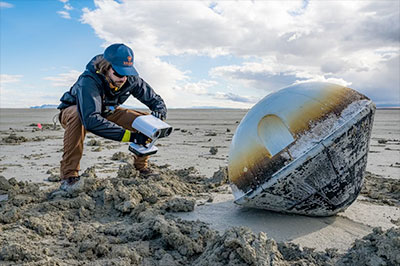|
|

|
|
Author
|
Topic: Varda Space Industries' W reentry capsules
|
Robert Pearlman
Editor Posts: 54063
From: Houston, TX
Registered: Nov 1999
|
 posted 02-22-2024 12:32 PM
posted 02-22-2024 12:32 PM
   
Varda Space Industries release Free-flying orbital production satellites with reentry capabilityVarda's W-Series spacecraft is a free flyer—it's self-sustaining, fully independent of other space stations, and capable of reentry to bring materials back to Earth for post processing. The reentry capsule completes the logistics chain, allowing orbital materials an inexpensive ride back to Earth while operating as a reentry research platform due to its frequent flights.  Varda's W-Series stands alone as the only all-in-one commercial satellite and reentry vehicle built specifically for the return of materials from orbit. Other operational reentry vehicles are built with humans in mind, meaning significant cost increases from the life support systems and other amenities needed to sustain astronauts. Free-flying Varda's W-series is a self-sustaining space satellite, not relying on other space vehicles such as the ISS. This gives our vehicle complete freedom to operate according to the precise needs and timing of our customers. Ballistic Reentry Given the lack of humans on board, Varda's capsule reenters passively, dramatically lowering costs while operating in an environment of interest for a wide array of government customers. Terrestrial landing The W-Series has been built for terrestrial landing, meaning recovery operations are simpler and cheaper than costly and timely ocean recoveries. Rapid Production & Flight The W-Series is built for ease of manufacturing and frequent launches and landings—the first mass-produced reentry vehicle and orbital production facility in human history. |
Robert Pearlman
Editor Posts: 54063
From: Houston, TX
Registered: Nov 1999
|
 posted 02-22-2024 12:38 PM
posted 02-22-2024 12:38 PM
   
Rocket Lab release Rocket Lab Successfully Returns Spacecraft Capsule to Earth, Brings Back Pharmaceuticals Made in SpaceThe Rocket Lab spacecraft designed, built, and operated for Varda Space Industries which enabled the production of pharmaceutical products on orbit, has been returned to Earth. Rocket Lab USA, Inc., announced its custom spacecraft for Varda Space Industries successfully returned to Earth the world's first space manufacturing mission conducted outside of the International Space Station.  Rocket Lab conducted in-space operations, deorbit, and reentry positioning maneuvers for its spacecraft, enabling Varda's reentry capsule and payload of pharmaceutical crystals to return to Earth. With Rocket Lab's role in the mission complete, the Varda team then took over management of the capsule's hypersonic reentry, parachute deployment, and touchdown in the designated zone at the Utah Test and Training Range (UTTR) near Salt Lake City shortly after 21:30 UTC (4:30 p.m. EST) on Feb. 21. The mission is a successful demonstration of Rocket Lab's end-to-end space systems solutions tailored to enable novel and innovative missions for a range of customers. Rocket Lab designed, manufactured and operated a bespoke spacecraft to enable Varda's capsule manufacturing demonstration. The spacecraft included a full suite of Rocket Lab sub-systems and components built in-house, spanning spacecraft engine, flight software, avionics, reaction wheels, star trackers, capsule dispenser, solar panels, radio, composite structures and tanks, and more. While initially designed for a four-month lifespan on orbit, the mission timeline was more than doubled with Rocket Lab's spacecraft successfully provided power, communications, ground control, and attitude control to Varda's capsule on orbit for more than eight months. This enabled Varda's capsule to grow Ritonavir crystals, commonly used in antiviral medication. As particles function differently when no longer under the force of gravity, Varda's capsule utilizes microgravity conditions in space to formulate a range of pharmaceutical products.  Rocket Lab also supported the mission with 24/7 satellite operations to return Varda's capsule to Earth. Rocket Lab's operations team completed multiple on-orbit trajectory optimization maneuvers that set the mission on its return-to-Earth trajectory, including four engine relights of Rocket Lab's 3D printed Curie propulsion system to move Varda's mission from a circular Earth orbit to an elliptical one, positioning Varda's capsule for a return to Earth at hypersonic speeds greater than Mach 25, or approximately 30,000 km per hour. Deploying Varda's capsule on a hypersonic reentry trajectory to land within the incredibly tight boundaries of the mission's landing zone within the UTTR was an especially complex task that demanded pinpoint accuracy with a margin of error of less than 0.05%. Varda's recovery operations are now in full swing and once the capsule is retrieved by Varda, the company will conduct laboratory analysis of the space-grown crystals and determine its next steps for commercializing orbital drug processing and microgravity manufacturing. Peter Beck, Rocket Lab founder and CEO, says: "This mission was a phenomenal feat and impressive display of teamwork between the Rocket Lab and Varda teams to develop a unique and highly capable spacecraft, successfully demonstrate in-space manufacturing, and bring back the capsule and finished pharmaceutical product – all on the first attempt. Being part of the first pharmaceutical in-space mission to happen outside of the International Space Station is immensely exciting and we look forward to building on this success with more Rocket Lab spacecraft in development for Varda right now. The success of this reentry mission will also inform our work on developing a reentry capsule for Neutron to potentially enable human spaceflight missions." The returned mission is the first of four Rocket Lab spacecraft ordered by Varda to support its in-space pharmaceutical processing. The remaining spacecraft are currently undergoing assembly, integration, and testing at Rocket Lab's spacecraft production facility in Long Beach, California, with the next spacecraft scheduled to launch before the end of the year. These spacecraft for Varda are just some of the 25+ spacecraft currently under development at Rocket Lab's advanced spacecraft development and manufacturing complex, which features a 10,000 sq. ft. cleanroom and 40,000 sq. ft. of production & test facilities designed to support constellation class manufacturing and satellite assembly, integration and test for commercial, civil and national security customers. |
Robert Pearlman
Editor Posts: 54063
From: Houston, TX
Registered: Nov 1999
|
 posted 01-14-2025 03:25 PM
posted 01-14-2025 03:25 PM
   
Varda Space release Varda's Second Mission, W-2, Launches with Payloads from Air Force Research Laboratory and NASA The microgravity-enabled life sciences company offers real-world, recoverable reentry flight tests for government partners, in addition to its research that expands capabilities for in-space pharmaceutical processing. Varda Space Industries, Inc. today announced the successful launch of its second orbital processing and reentry capsule, W-2, which lifted off aboard the Transporter-12 rideshare mission with SpaceX from Vandenberg Space Force Base in California. The W-2 capsule carries payloads from Varda partners, including a spectrometer from the Air Force Research Laboratory (AFRL), and employs a heatshield with a Thermal Protection System (TPS) developed in collaboration with NASA's Ames Research Center in California's Silicon Valley. These payloads are in addition to Varda's expanded pharmaceutical reactor. AFRL leads the discovery, development, and delivery of novel aerospace technologies, and Varda is honored to fly AFRL's Optical Sensing of Plasmas in the Reentry Environment (OSPREE) payload on W-2. OSPREE is an optical emission spectroscopy system designed to record spectral measurements of the dynamic reentry plasma environment. The sensor will yield the first in situ optical emission measurements of the reentry environment past Mach 15 in history. OSPREE is the first DoD payload experiment to be flown on Varda's hypersonic testbed, which offers true reentry flight heritage for materials and sensors in excess of Mach 25. High-hypersonic flow conditions are impossible to replicate on the ground, and flight testing is the only way to advance our understanding of the unique aerothermal chemistry experienced by spacecraft on their way back to Earth. Additionally, most test vehicles are not recoverable and are often limited to lower hypersonic conditions that do not provide a complete picture of the environment with adequate heat loads, pressures, and plasma formation. The Prometheus program, a partnership between Varda and AFRL, addresses a national security need to accelerate the ability to test and modernize high-hypersonic systems and reentry technologies through a low-cost, high cadence flight testbed. AFRL recently awarded Varda a flight services Indefinite Delivery, Indefinite Quantity contract to fund and access flights through 2028. "By partnering with the commercial space industry, AFRL can provide the Government S&T community with a novel, low-cost approach to iterative development. Prometheus fills a longstanding experimentation gap for the maturation of future reentry system technologies," said Dr. Erin Vaughan, AFRL Prometheus Lead. "Varda is proud to leverage its flight-proven commercial reentry capability as a hypersonic testbed, which we hope will be a reliable foundation for advancing the hypersonic sector. Deepening our understanding of the reentry environment accelerates defense capabilities while also advancing commercial space," said Varda CEO Will Bruey. "As we grow the orbital economy, reentry will be as common as launch. Varda's first hypersonic testbed mission, through our key partnership with AFRL, is in service of that goal." The W-2 capsule will orbit via a Rocket Lab Pioneer satellite bus and will reenter at Koonibba Test Range in South Australia, operated by Southern Launch. |
Robert Pearlman
Editor Posts: 54063
From: Houston, TX
Registered: Nov 1999
|
 posted 02-27-2025 09:04 PM
posted 02-27-2025 09:04 PM
   
Varda Space update (via X) We can confirm that at 6:32 a.m. Pacific Time Zone the W-2 capsule landed safely at the Koonibba Test Range, operated by Southern Launch, becoming the first-ever commercial spacecraft to reenter on Australian soil.We will share more details soon, but for now, we're proud to have successfully completed our second mission. Welcome home, W-2! And congratulations to all our partners.  | |
Contact Us | The Source for Space History & Artifacts
Copyright 1999-2025 collectSPACE. All rights reserved.

Ultimate Bulletin Board 5.47a
|
|

|
 advertisement advertisement

|















